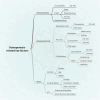Effect of chitosan/inorganic nanomaterial scaffolds on bone regeneration and related influencing factors in animal models: A systematic review
- PMID: 36394038
- PMCID: PMC9643585
- DOI: 10.3389/fbioe.2022.986212
Effect of chitosan/inorganic nanomaterial scaffolds on bone regeneration and related influencing factors in animal models: A systematic review
Erratum in
-
Erratum: Effect of chitosan/inorganic nanomaterial scaffolds on bone regeneration and related influencing factors in animal models: a systematic review.Front Bioeng Biotechnol. 2025 Feb 3;13:1562494. doi: 10.3389/fbioe.2025.1562494. eCollection 2025. Front Bioeng Biotechnol. 2025. PMID: 39963170 Free PMC article.
Abstract
Bone tissue engineering (BTE) provides a promising alternative for transplanting. Due to biocompatibility and biodegradability, chitosan-based scaffolds have been extensively studied. In recent years, many inorganic nanomaterials have been utilized to modify the performance of chitosan-based materials. In order to ascertain the impact of chitosan/inorganic nanomaterial scaffolds on bone regeneration and related key factors, this study presents a systematic comparison of various scaffolds in the calvarial critical-sized defect (CSD) model. A total of four electronic databases were searched without publication date or language restrictions up to April 2022. The Animal Research Reporting of In Vivo Experiments 2.0 guidelines (ARRIVE 2.0) were used to assess the quality of the included studies. Moreover, the risk of bias (RoB) was evaluated via the Systematic Review Center for Laboratory Animal Experimentation (SYRCLE) tool. After the screening, 22 studies were selected. None of these studies achieved high quality or had a low RoB. In the available studies, scaffolds reconstructed bone defects in radically different extensions. Several significant factors were identified, including baseline characteristics, physicochemical properties of scaffolds, surgery details, and scanning or reconstruction parameters of micro-computed tomography (micro-CT). Further studies should focus on not only improving the osteogenic performance of the scaffolds but also increasing the credibility of studies through rigorous experimental design and normative reports.
Keywords: animal models; bone regeneration; calvarial bone defects; chitosan; inorganic nanomaterials.
Copyright © 2022 Guo, Zheng, Zhong, Mo and Fang.
Conflict of interest statement
The authors declare that the research was conducted in the absence of any commercial or financial relationships that could be construed as a potential conflict of interest.
Figures






Similar articles
-
Erratum: Effect of chitosan/inorganic nanomaterial scaffolds on bone regeneration and related influencing factors in animal models: a systematic review.Front Bioeng Biotechnol. 2025 Feb 3;13:1562494. doi: 10.3389/fbioe.2025.1562494. eCollection 2025. Front Bioeng Biotechnol. 2025. PMID: 39963170 Free PMC article.
-
Incorporation of copper into chitosan scaffolds promotes bone regeneration in rat calvarial defects.J Biomed Mater Res B Appl Biomater. 2015 Jul;103(5):1044-9. doi: 10.1002/jbm.b.33290. Epub 2014 Sep 17. J Biomed Mater Res B Appl Biomater. 2015. PMID: 25230382 Free PMC article.
-
Milestones in Mandibular Bone Tissue Engineering: A Systematic Review of Large Animal Models and Critical-Sized Defects.J Clin Med. 2025 Apr 15;14(8):2717. doi: 10.3390/jcm14082717. J Clin Med. 2025. PMID: 40283548 Free PMC article. Review.
-
GO/Cu Nanosheet-Integrated Hydrogel Platform as a Bioactive and Biocompatible Scaffold for Enhanced Calvarial Bone Regeneration.Int J Nanomedicine. 2024 Aug 14;19:8309-8336. doi: 10.2147/IJN.S467886. eCollection 2024. Int J Nanomedicine. 2024. PMID: 39161358 Free PMC article.
-
GelMA-based bioactive hydrogel scaffolds with multiple bone defect repair functions: therapeutic strategies and recent advances.Biomater Res. 2023 Sep 15;27(1):86. doi: 10.1186/s40824-023-00422-6. Biomater Res. 2023. PMID: 37715230 Free PMC article. Review.
Cited by
-
Bone Regeneration with Mesenchymal Stem Cells in Scaffolds: Systematic Review of Human Clinical Trials.Stem Cell Rev Rep. 2024 May;20(4):938-966. doi: 10.1007/s12015-024-10696-5. Epub 2024 Feb 26. Stem Cell Rev Rep. 2024. PMID: 38407793 Free PMC article.
-
Biodegradable Polymers in Veterinary Medicine-A Review.Molecules. 2024 Feb 17;29(4):883. doi: 10.3390/molecules29040883. Molecules. 2024. PMID: 38398635 Free PMC article. Review.
-
Reporting quality of animal research in journals that published the ARRIVE 1.0 or ARRIVE 2.0 guidelines: a cross-sectional analysis of 943 studies.Cardiovasc Diagn Ther. 2024 Dec 31;14(6):1070-1082. doi: 10.21037/cdt-24-413. Epub 2024 Dec 17. Cardiovasc Diagn Ther. 2024. PMID: 39790189 Free PMC article.
-
Mechanism research of elastic fixation promoting fracture healing based on proteomics and fracture microenvironment.Bone Joint Res. 2024 Oct 8;13(10):559-572. doi: 10.1302/2046-3758.1310.BJR-2023-0257.R2. Bone Joint Res. 2024. PMID: 39377775 Free PMC article.
References
Publication types
LinkOut - more resources
Full Text Sources
Miscellaneous

